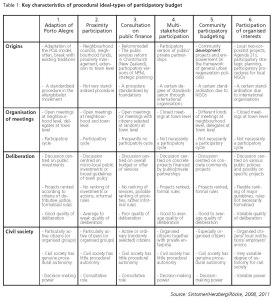The Participatory Budget (PB) model has been spread all over the world; more than 1000 cities globally have implemented models of PB so far. But as the term “local participation” has been used to describe a variety of different models and programs some more participatory than others, in the same way PB is used to describe a wide range of disparate activities (Paterman 2012). Many cities experiment with PB to strengthen civil society, other to democratise society, to fight corruption or to give legitimacy to austerity measures (Sintomer 2010). In many cases citizens are discussing extremely small and vapid chunks of the municipal budget (Paterman 2012).
Despite of how diverse the different PB models are, they have one basic principal in common: “they are a trust-building measure” (Sintomer 2010). Improving the relationship and communication between the citizens and local governments.
The processes and outcomes of the PB implementation vary according to the conditions the citizens are facing, the political traditions, the decentralization of governance and so on. Sintomer and his team distinguished a typology of procedures that has become widespread around the world. They presented six models:
• Adaptation of Porto Alegre • Proximity participation • Consultation on public finance • Multi-stakeholder participation • Community participatory budgeting • Participation of organised interests (Sintomer 2010)
In the above table we can see the basic characteristics of each model and the differences between them. To sum up the table, the PB experiments all over the world differ according to whether the role of civil society is decision-making or consulative, if they deliberate on all the municipal budget or part of it and the degree of deliberation, and finally and more importantly who participates. Apart from the local government-civil society model there are also examples of community PB where the local government has little or no role and the budget comes from the community itself whereas other examples include the participation of private stakeholders and NGO’s and exclude unorganized citizens.
An example of Community PB is the British city of Bradford which has set its own community fund independent from the municipal budget. The money for the fund is usually provided by international organizations, private companies and NGO’s. A committee that includes citizen delegates has the final say for the allocation of the money; the citizens have also the responsibility to implement the proposed projects (Sintomer 2010).
In Europe the PB model has spread rapidly mainly because of the high degree of electoral abstinence in combination with a general dissatisfaction towards local governments and severe financial problems. Most examples in Europe (Italy, Portugal, Scandinavia, Germany) belong to the Proximity Participation where the role of the citizens is mainly consultative. We can distinguish three steps in this process: information, consultation, and accountability. People are informed on municipality’s financial condition; understand where the money comes from and how it is used and finally make suggestions for improvements of the public services (Sintomer 2010).
The PB model has mutated through the years not only because for its implementation in different settings but also because of the use of digital and online tools.
As mentioned in the introductory post of the PB series, the mayor of San Francisco announced a month ago (September 2013) the implementation of an online Participatory Budget system. The first example of digital PB came in 2006 by the city of Belo Horizonte in Brazil. This triggered the expanded use of ICTs in nearly all PB’s in various degrees.
The objectives for the use of digital tools are: first, to increase citizen involvement in the process, and second, to “scale-up” in order to include bigger investments that influence the city as a whole. Online voting, internet debates, collaborative wiki, video streaming of assemblies, online submission of proposals, sms updates, access to further information are some of the digital tools that have been used in various cases of PB.
The bigger danger of the e-Participatory Budget is the loss of the deliberative dimension of the model and its transformation to a general referendum (Sintomer 2010). In the next post we will see the outcomes of the PB experiments ….See more
References
Peixoto, T., Participatory Budgeting & Technology: Innovation in Open Government.
Pateman, C., 2012. Participatory Democracy Revisited. Perspectives on Politics, 10(01), pp.7–19.


